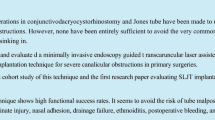Abstract
Purpose
To evaluate the efficacy of trephination and monocanalicular/bicanalicular silicone tube use depending on the number of affected canaliculi in patients with canalicular obstruction.
Methods
This retrospective study included 46 eyes of 36 patients who underwent trephination and silicone tube intubation performed by a single experienced oculoplastic surgeon due to canalicular obstruction between 2005 and 2020. Monocanalicular silicone tube was applied to patients with one canalicular obstruction, and bicanalicular silicone tube was applied to those with the upper and lower canalicular involvement of the same eye. Canalicular obstructions were divided into groups according to their localization as proximal, middle, and distal. The silicone tubes were kept in place for at least 5 months after the operation, and the follow-up duration of the patients was at least 12 months.
Results
Twenty (55.6%) patients were female and 16 (44.4%) were male. The mean age was 15.82 ± 7.02 years in the treatment success group and 28.87 ± 12.74 years in the treatment failure group (p = 0.001). While 67.6% of the eyes in the treatment success group had monocanalicular obstruction (monocanalicular silicone tube applied), 66.7% of those in the treatment failure group had bicanalicular obstruction (bicanalicular silicone tube applied) (p = 0.049). The most common distal obstruction was seen in the treatment success group, and the least distal obstruction and the most proximal obstruction were observed in the treatment failure group (p < 0.001). The mean duration silicone tube stay was 9.37 ± 1.96 months in the treatment success group and 7.25 ± 1.42 months in the treatment failure group (p = 0.003).
Conclusion
We consider that trephination with the use of a monocanalicular or bicanalicular silicone tube depending on the number of affected canaliculi can be the first choice of treatment in canalicular obstruction due to its high success rate, especially in distal obstruction.

Similar content being viewed by others
References
Shin JH, Kim YD, Woo KI (2015) Korean society of ophthalmic plastic and reconstructive surgery (KSOPRS). Impact of epiphora on vision-related quality of life. BMC Ophthalmol. 15:6
Ali MJ, Paulsen F (2020) Human lacrimal drainage system reconstruction, recanalization, and regeneration. Curr Eye Res. 45:241–252
Everman KR, Czyz CN, Kalwerisky K, Hill RH, Foster JA, Cahill KV (2012) Canalicular obstruction: a histopathologic case series. Can J Ophthalmol 47:500–503
Athanasiov PA, Madge S, Kakizaki H, Selva D (2011) A review of bypass tubes for proximal lacrimal drainage obstruction. Surv Ophthalmol 56:252–66
Rea IM, Gibson DS, McGilligan V, McNerlan SE, Alexander HD, Ross OA (2018) Age and age-related diseases: role of inflammation triggers and cytokines. Front Immunol 9:586
Ozer O, Eskiizmir G, Unlü H, Işisağ A, Aslan A (2012) Chronic inflammation: a poor prognostic factor for endoscopic dacryocystorhinostomy. Eur Arch Otorhinolaryngol 269:839–845
Zadeng Z, Singh M, Singh U (2014) Role of lacrimal canalicular trephination and mini-monoka stent in the management of idiopathic distal canalicular obstructions: our experience of 23 Cases. Asia Pac J Ophthalmol (Phila) 3:27–31
Khoubian JF, Kikkawa DO, Gonnering RS (2006) Trephination and silicone stent intubation for the treatment of canalicular obstruction: effect of the level of obstruction. Ophthalmic Plast Reconstr Surg 22:248–252
Kaufman LM, Guay-Bhatia LA (1998) Monocanalicular intubation with Monoka tubes for the treatment of congenital nasolacrimal duct obstruction. Ophthalmology 105:336–341
Satchi K, McNab AA (2019) Idiopathic acquired lacrimal canalicular obstruction. Ophthalmic Plast Reconstr Surg 35:266–268
Nathoo NA, Rath S, Wan D, Buffam F (2013) Trephination for canalicular obstruction: experience in 45 eyes. Orbit 32:281–284
Funding
There was not any funding for this work.
Author information
Authors and Affiliations
Corresponding author
Ethics declarations
Conflict of interest
The authors have not disclosed any conflict of interest.
Additional information
Publisher's Note
Springer Nature remains neutral with regard to jurisdictional claims in published maps and institutional affiliations.
Rights and permissions
Springer Nature or its licensor holds exclusive rights to this article under a publishing agreement with the author(s) or other rightsholder(s); author self-archiving of the accepted manuscript version of this article is solely governed by the terms of such publishing agreement and applicable law.
About this article
Cite this article
Sahan, B., Ciftci, F. Trephination and silicone tube intubation in the treatment of canalicular obstruction. Int Ophthalmol 43, 541–547 (2023). https://doi.org/10.1007/s10792-022-02453-9
Received:
Accepted:
Published:
Issue Date:
DOI: https://doi.org/10.1007/s10792-022-02453-9




